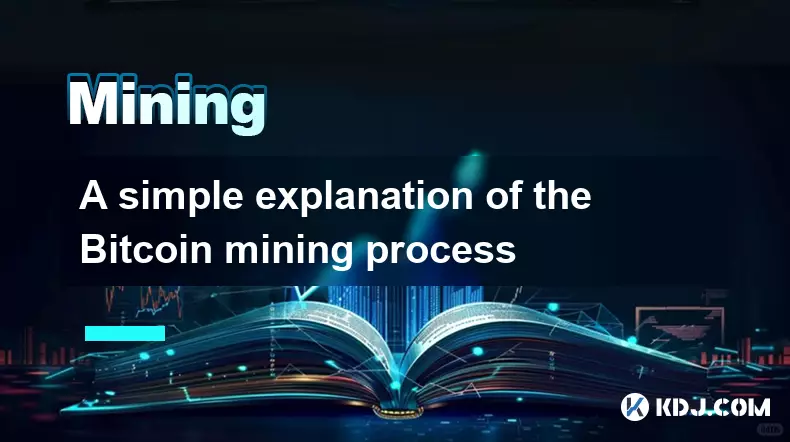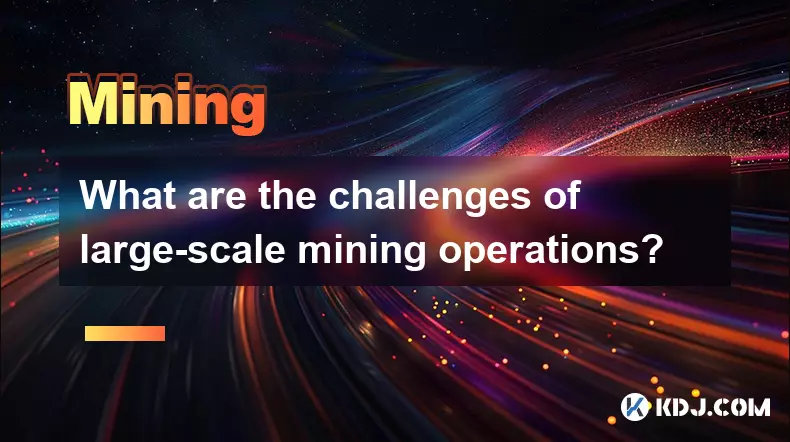-
 bitcoin
bitcoin $108221.513755 USD
-0.10% -
 ethereum
ethereum $3817.049350 USD
-1.16% -
 tether
tether $1.000184 USD
-0.03% -
 bnb
bnb $1081.373706 USD
1.55% -
 xrp
xrp $2.367284 USD
-2.30% -
 solana
solana $180.847708 USD
-3.07% -
 usd-coin
usd-coin $0.999936 USD
0.00% -
 tron
tron $0.322230 USD
-0.06% -
 dogecoin
dogecoin $0.190590 USD
-1.92% -
 cardano
cardano $0.626657 USD
-2.42% -
 hyperliquid
hyperliquid $37.280123 USD
6.15% -
 chainlink
chainlink $17.222315 USD
-2.46% -
 ethena-usde
ethena-usde $0.999312 USD
-0.03% -
 stellar
stellar $0.309699 USD
-0.98% -
 bitcoin-cash
bitcoin-cash $475.445788 USD
-1.02%
How to get started with Litecoin mining?
Litecoin mining uses Scrypt-based ASICs to solve complex problems, with profitability depending on hardware efficiency, electricity costs, and network difficulty.
Oct 19, 2025 at 07:01 am

Understanding Litecoin Mining Basics
1. Litecoin mining involves verifying transactions on the Litecoin blockchain using computational power. Miners solve complex mathematical problems to add new blocks and earn rewards in LTC.
2. Unlike Bitcoin, Litecoin uses the Scrypt hashing algorithm, which favors memory-intensive calculations over raw processing power. This makes it more accessible for individual miners with specialized hardware.
3. The network adjusts mining difficulty every 2016 blocks to maintain a consistent block time of approximately 2.5 minutes. This ensures stability and predictability in block generation.
4. Mining profitability depends on electricity costs, hash rate, and equipment efficiency. It's crucial to assess these factors before investing in mining gear.
5. Solo mining is rarely profitable due to high competition. Most miners join pools to combine hash power and receive steady payouts based on contribution.
Selecting the Right Hardware
1. ASIC miners designed for Scrypt are the only viable option for profitable Litecoin mining today. GPUs and CPUs cannot compete with ASIC efficiency.
2. Popular models include the Antminer L7, Innosilicon A6+, and Bitmain L7. These devices offer high hash rates ranging from 8,000 to over 12,000 MH/s.
3. Power consumption is a major consideration. High-performance ASICs can draw 2,500 to 3,500 watts. Ensure your electrical infrastructure supports continuous operation.
4. Always calculate return on investment by comparing upfront hardware cost, power usage, and current Litecoin price. Online calculators like WhatToMine provide real-time estimates.
5. Purchase equipment from reputable suppliers to avoid counterfeit or defective units. Consider second-hand options but verify performance history and warranty status.
Setting Up Your Mining Operation
1. Choose a mining pool such as Prohashing, F2Pool, or ViaBTC. Register an account and create a worker profile for each mining device.
2. Install firmware on your ASIC miner and configure network settings. Connect via Ethernet for stable communication with the pool server.
3. Input the pool’s stratum URL, port number, and your worker credentials into the miner’s configuration interface. Double-check for typos to prevent downtime.
4. Monitor temperature and fan speeds regularly. Overheating reduces lifespan and efficiency. Adequate ventilation or dedicated cooling systems are essential.
5. Update firmware periodically to benefit from performance improvements and bug fixes released by manufacturers. Stay informed through official support channels.
Managing Rewards and Security
1. Set up a secure Litecoin wallet to receive payouts. Hardware wallets like Ledger or Trezor offer the highest protection against theft.
2. Pools distribute earnings based on share contributions. Payment methods include PPLNS (Pay Per Last N Shares) and PROP (Proportional), affecting payout frequency and consistency.
3. Enable two-factor authentication on your pool account. Use strong, unique passwords and avoid public Wi-Fi when accessing mining dashboards.
4. Track income, expenses, and hash rate performance using spreadsheet tools or dedicated software like Hive OS or Awesome Miner.
5. Report mining income accurately for tax purposes, as regulatory bodies increasingly monitor cryptocurrency activities.
Frequently Asked Questions
Can I mine Litecoin with my home computer?No, modern Litecoin mining requires Scrypt-based ASIC miners. Consumer-grade CPUs and GPUs lack the necessary efficiency and hash power to generate meaningful returns.
How much does it cost to start Litecoin mining?Initial costs range from $1,500 to over $4,000 depending on the ASIC model. Additional expenses include power supply units, cooling, and electricity over time.
Is Litecoin mining still profitable in 2024?Profitability varies by region and setup. Locations with low electricity rates and efficient hardware can achieve positive margins, especially when Litecoin’s market price remains stable or increases.
What happens if the mining difficulty increases?Higher difficulty means more computational work is needed per block. This reduces individual payout rates unless hash power is increased, directly impacting profitability for fixed setups.
Disclaimer:info@kdj.com
The information provided is not trading advice. kdj.com does not assume any responsibility for any investments made based on the information provided in this article. Cryptocurrencies are highly volatile and it is highly recommended that you invest with caution after thorough research!
If you believe that the content used on this website infringes your copyright, please contact us immediately (info@kdj.com) and we will delete it promptly.
- Essex Post Office, 5p Coins, and King Charles: A Royal Mint Revelation!
- 2025-10-23 10:30:16
- Waymo's Newark Airport AV Tests: Alphabet's AI Gamble Pays Off?
- 2025-10-23 10:30:16
- King Charles 5p Coins: A Royal Flush in Your Pocket?
- 2025-10-23 10:35:18
- Solana, Crypto Advisory, and Forward Industries: A New York Minute on the Future of Finance
- 2025-10-23 08:51:22
- MAGACOIN: Ethereum Whales Dive into the Hottest Presale of 2025
- 2025-10-23 08:51:22
- Kadena's End of the Road? KDA Token Plummets Amid Project Abandonment
- 2025-10-23 08:55:34
Related knowledge

A simple explanation of the Bitcoin mining process
Oct 21,2025 at 05:54am
What Is Bitcoin Mining?1. Bitcoin mining is the process by which new bitcoins are introduced into circulation and transactions are verified on the blo...

How to get started with Litecoin mining?
Oct 19,2025 at 07:01am
Understanding Litecoin Mining Basics1. Litecoin mining involves verifying transactions on the Litecoin blockchain using computational power. Miners so...

What are the challenges of large-scale mining operations?
Oct 18,2025 at 07:01pm
Energy Consumption and Power Management1. Large-scale mining operations require massive amounts of electricity to power thousands of ASICs or GPUs run...

How to manage the heat and noise from a mining rig?
Oct 22,2025 at 05:36pm
Optimizing Ventilation for Mining Rigs1. Proper airflow is essential when running a mining rig continuously. Position the rig in a well-ventilated roo...

Can a Raspberry Pi be used for crypto mining?
Oct 21,2025 at 04:18pm
Feasibility of Using Raspberry Pi for Cryptocurrency Mining1. The Raspberry Pi is a compact, low-power single-board computer designed primarily for ed...

What is the break-even point for a mining investment?
Oct 21,2025 at 03:36am
Understanding the Break-Even Point in Cryptocurrency MiningThe break-even point in cryptocurrency mining refers to the moment when the total revenue g...

A simple explanation of the Bitcoin mining process
Oct 21,2025 at 05:54am
What Is Bitcoin Mining?1. Bitcoin mining is the process by which new bitcoins are introduced into circulation and transactions are verified on the blo...

How to get started with Litecoin mining?
Oct 19,2025 at 07:01am
Understanding Litecoin Mining Basics1. Litecoin mining involves verifying transactions on the Litecoin blockchain using computational power. Miners so...

What are the challenges of large-scale mining operations?
Oct 18,2025 at 07:01pm
Energy Consumption and Power Management1. Large-scale mining operations require massive amounts of electricity to power thousands of ASICs or GPUs run...

How to manage the heat and noise from a mining rig?
Oct 22,2025 at 05:36pm
Optimizing Ventilation for Mining Rigs1. Proper airflow is essential when running a mining rig continuously. Position the rig in a well-ventilated roo...

Can a Raspberry Pi be used for crypto mining?
Oct 21,2025 at 04:18pm
Feasibility of Using Raspberry Pi for Cryptocurrency Mining1. The Raspberry Pi is a compact, low-power single-board computer designed primarily for ed...

What is the break-even point for a mining investment?
Oct 21,2025 at 03:36am
Understanding the Break-Even Point in Cryptocurrency MiningThe break-even point in cryptocurrency mining refers to the moment when the total revenue g...
See all articles










































































